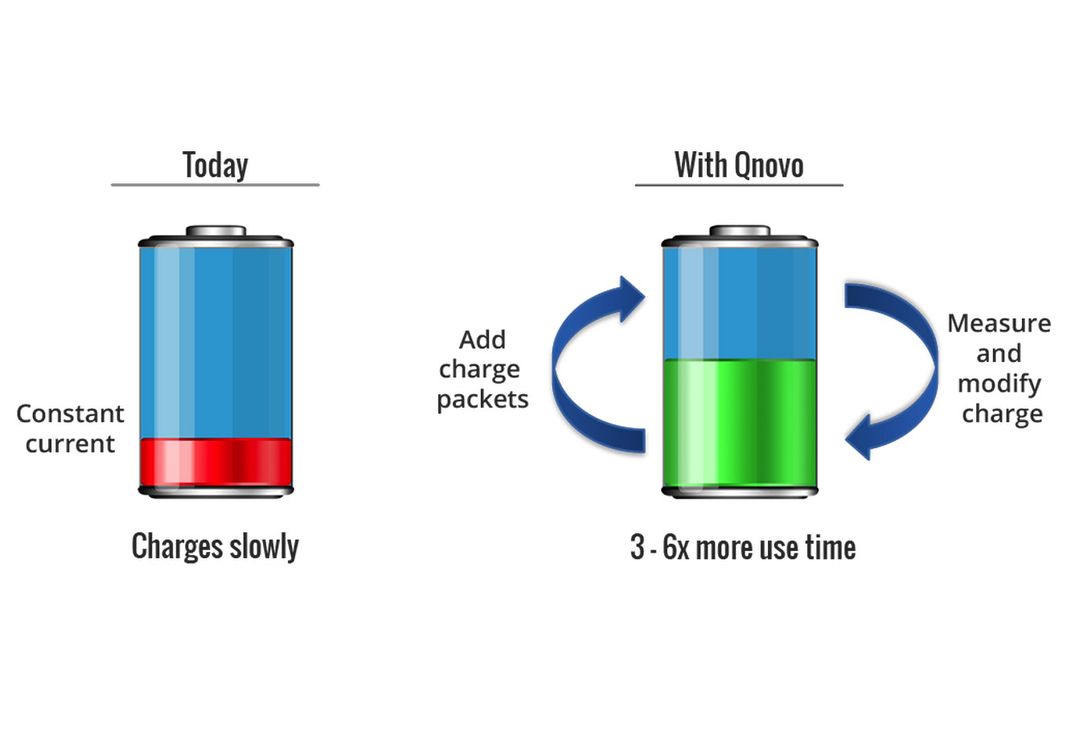Your Next Smartphone Could Charge Six Times Faster
A California startup is implementing faster, smarter charging for next year’s mobile devices
:focal(3075x1230:3076x1231)/https://tf-cmsv2-smithsonianmag-media.s3.amazonaws.com/filer/9d/cb/9dcbb1cf-a344-47ec-b91c-d1ca15c5d691/smartphone-charging.jpg)
As our mobile devices get thinner and thinner, researchers are racing to pack more power into ever-smaller batteries. But battery capacities and densities haven’t kept up with the advancements in other areas of electronics. So, the California-based Qnovo Corporation is taking a different approach to making sure our smartphones don’t conk out before the end of the day.
Instead of working on increasing battery capacity, Qnovo’s technology focuses on faster, smarter charging, which means your next phone or tablet could charge three to six times faster than the device you’re using now. The company claims its technology will let you plug your phone in for 15 minutes at lunch and get an extra six hours of use time.

How does it work? Device makers today limit charge speed to a rate that all batteries can handle without getting damaged. Instead of sticking to a slower speed that’s safe for all batteries, Qnovo has developed software that periodically sends a signal to the battery and measures the voltage response. By doing this, the company claims they can determine the battery’s temperature and other stress factors. With this information, they can adjust the charging rate to deliver as much current as the battery can handle, while maintaining the 500 to 800 charge cycles device makers expect their batteries to deliver.
This smarter form of charging, not dissimilar to the way modern processors adjust their clock speeds to efficiently perform different tasks, seems like an idea that smartphone makers would have implemented years ago. But Robert Nalesnik, Qnovo’s vice president of marketing, says that there was a lack of communication between two key parties.
“Battery chemists really didn’t talk to the electrical engineers in the large battery companies. Those tended to be totally different domains,” says Nalesnik. “The thesis [early on at Qnovo] was that if we put battery chemists together with electrical engineers, we can come up with a more creative way to solve that problem.”
Indeed, the company’s trio of founders includes Nadim Maluf, a former Stanford consulting professor of electrical engineering; Dania Ghantous, a chemical engineer with a specialty in lithium-ion batteries; and Fred Berkowitz, a former Apple Macbook engineer.
Qnovo isn’t the only company working on fast charging. Qualcomm, makers of chips in many high-end tablets and smartphones, is already shipping Quick Charge 2.0-enabled devices, which the company says charge in 75 percent less time.
But Nalesnik says Qnovo’s technology will not compete with Qualcomm’s, but rather compliment it. He says Qualcomm has helped the situation by moving away from the 5-volt USB standard, and creating a “handshake” between the adapter and the device, so that the voltage and power can be increased. Because of this, device chargers can move from a traditional 5 watts to delivering up to 18 watts.
Nalesnik says Qnovo takes that extra incoming power and delivers it smartly to the device. “We sit between the charger and the mobile device,” says Nalesnik. “Think of us as the traffic cop that determines how much of that power goes to the battery.”
The company has two adaptive charging solutions in the works. One is based purely on software, and allows Qnovo to vary power delivery every several seconds. A second hardware-based solution, which would require device makers to include a tiny chip, should allow for even faster charging, as it can adjust power every several milliseconds.
“In the software case, we instruct the charger to change its current,” says Nalesnik. “In the hardware case, there’s actually a transistor that manages the current, and we basically turn that current on and off as it goes to the battery.”
While one of the company’s technologies relies entirely on software, don’t expect to just be able to download an app and instantly increase your charge time. Apps don’t have the ability to tinker with charging rates because of safety issues. If a battery is improperly charged, it can get extremely hot, swell up and, in extreme cases, even catch fire or explode.
So the company’s software implementation, called QNS, will instead have to be baked into the kernel of future operating system updates. Qnovo has, however, shown QNS working on a Google Nexus 5 smartphone running a modified version of Android. The company claims charge time is roughly cut in half, with the QNS-enabled phone delivering an extra 2.5 hours of talk time for every 10 minutes of charging.
Nalesnik says Qnovo is working with most major mobile device makers to deliver its technology in future models. He expects the first smart-charging Qnovo-equipped tablets and smartphones to arrive in 2015, with software-only devices arriving first and the faster-charging hardware implementation coming to devices later in the year.
/https://tf-cmsv2-smithsonianmag-media.s3.amazonaws.com/accounts/headshot/unnamed.jpg)


/https://tf-cmsv2-smithsonianmag-media.s3.amazonaws.com/accounts/headshot/unnamed.jpg)